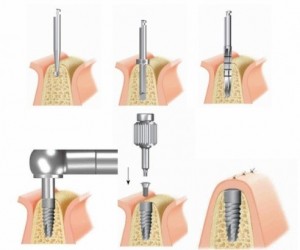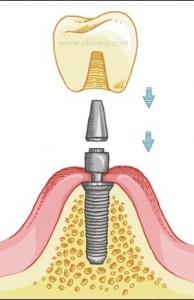Dental implant
A large part of the population suffers from lack of teeth (edentulous), that is to say the lack of one or several teeth. This absence of teeth affects health because does not allow a good chewing food, and the remaining teeth in the mouth undergo all the masticatory force. For several years, treatments replacing missing teeth,made by bridges and removable appliances (dentures). But now there are also implants.
An implant resembles a cylinder and generally smaller titanium, which is fixed in the jawbone. The implant replaces the root of the tooth which provides a solid basis for a prosthesis or crown, and the tooth regains its strength and good masticatory function.
->
Dental implants are fixed to the bone by osseointegration, that is to say that the bone is in intimate contact with the implant, supportant each mastication almost normal.
->
Advantages of Dental implants
->
-Improved aesthetics, because the implants look like real teeth. More, they are fused with the bone, implants become permanent.
-Speech enhancement, because unlike dentures which can move when talking, implants allow you to talk without worrying instability.
-Improved comfort, because the implants will be part of the mouth, giving the feel of real teeth.
-Eat more easily, Unlike dentures, which can be unstable in the mouth.
-The implants do not require touch (cut) tooth side as in the case of dental bridges
-Implants last several years. They need the same care as real teeth, that is to say the brush, floss, and regular dental visits. With the right care, implants can last a lifetime, denture or crown part to be changed every 10-15 years.
->
Success rate of implants
Success rates vary, depend on the location in the mouth where the implants are placed, and the condition of the bone that support the. In general, implants successfully 97%. With good care, this success can last a lifetime. The success rate is lower in smokers.
People with diabetes disorders, heart disease, or who received doses of radiation to the head and neck, must be carefully evaluated before being put implants.
->
Steps of placing an implant
An individualized treatment plan is established by the dentist according to the patient's needs,  the state of his mouth and his health.
the state of his mouth and his health.
Part "root" of the implant is then placed into the alveolar bone. This portion of the implant made of titanium like a pivot of a few millimeters in diameter. This mini surgical procedure is performed under local anesthesia .
->
When the bone heals, It is encrusted around the implant giving it a very solid anchor.
Once the implant is anchored to the alveolar bone, a connection bracket is attached to

->
The healing stage
the implant to hold the crown or prosthesis.takes a few weeks.
The dentist should take an impression connections media, as well as the other teeth of the mouth there, to make the crown or prosthesis.
->
